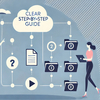
Software documentation is typically included in the packaging of all newly released digital products. Creating software documentation is a crucial step in ensuring that users know how to use your program properly. Software documentation helps achieve optimal UX standards, providing users with the knowledge they need to use the product on a daily basis.
In addition, software documentation is important for technical writers. As the company’s knowledge base expands and documents accumulate, authors require less and less time to produce new content. This follows a standard procedure for today’s reuse-based content production process. Component authoring allows your writing team to create new publications while utilizing the same or comparable code and text parts repeatedly. This approach frees up time and resources for developing new products and creative projects.
This blog will describe the key components of effective software documentation and explain how to create it.
Software Documentation: What Is It?
The content your technical writing team produces to support your product is called software documentation, or SD. SD is developed at various phases of the product life cycle, from familiarizing users with the product to fully integrating the software into the customer’s system.
Initially, supporting material may take the form of a QSG (quick start guide), explaining crucial aspects of the product, such as installation, authentication, settings, and requirements. This information might be presented as instructions or case studies, using real-life examples to address the most complex issues.
As the product progresses, additional documentation becomes necessary. This includes user experience documents, like user guides, designed to enhance the usability of the digital product. From the product developer’s perspective, UX documents aim to optimize how potential customers interact with the product, incorporating elements such as user scenarios and detailed user personas.
At the final stage, SD encompasses metrics and reports that help track the application’s effectiveness.
General Recommendations for Writing Software Documentation That Works
First of all, try to develop a documentation strategy before you begin writing. Include your thoughts on the overall goal and content of the knowledge base in a program paper. Your vision for how the documentation will benefit all parties involved (internally and externally) should be crystal clear:
- Internally. Ensure co-authoring, single sourcing, and document reuse for company stakeholders. Writers should efficiently reuse previously prepared documents and collaborate while using the same sources in their daily tasks;
- Externally. Assist customers, who are stakeholders outside the organization, in making the best use of your digital offering.
The responsibility of creating SD should be given to a writer with technical experience.
The content will be more interesting for users if it is prepared by a writer with prior knowledge in the field of engineering or IT, providing users with a more in-depth understanding of the product.
Another advantage of having technical expertise is that you will have fewer errors in your documentation. Such errors are often caused by incorrect terminology or a misunderstanding of the procedure.
Combining the abilities of a developer with a writer is one potential solution to this issue. Hiring a tech writer with technical experience, as previously mentioned, would help achieve this. Another common practice in many organizations is having engineers write software documentation.
However, there is a problem with the latter approach. The overall tone of the article may decline even though there may be fewer technical errors. This is because the writing abilities of developers are typically far from flawless. The quality of the content may decrease if engineers and developers are given complete control over the task of generating technical documentation, as they often lack knowledge about document style.
Therefore, it is ideal for engineers and technical writers to communicate throughout the entire product life cycle rather than working independently. Developers should be active in the content review process and should collaborate closely with writers.
Separating documentation into coding and testing docs is another piece of advice. Coding documentation demonstrates the functionality of the digital output, requiring a strong foundation in information technology. Professionals with a blend of writing and technical talents should be assigned to explain complicated portions of a code.
A sizable body of material aiding in describing the testing procedure is the testing documentation. For example, a Test Plan or a Test Procedure Description refers to this set of documents.
It is crucial to consider the psychological component as well. Avoid being overly fixated on creating supporting documentation. Paradoxically, it might not be in your best interests to promote the digital product at every level. Trying to cover every potential bottleneck can result in a ton of technical and jargon-heavy content that readers may never understand.
A product overloaded with documentation appears too complicated to the user. Try to create an intuitive app rather than providing documentation that needs explanation. People simply won’t read documents that appear to be academic papers on nuclear physics. Make an effort to provide information in a straightforward, approachable way.
Another often-used technique for supporting a digital product is cross-linking. Links that take the reader from the current page to related topics on the previous or following pages, where the phrase or notion will be described in detail, are essential features of effective SD. Cross-linking gives your material extra possibilities. It becomes clearer and more compact as a result. You can cite just one source rather than duplicating the term across multiple pages, helping you free up space on the page.

10 Tips for Content Structuring of Your Software Documentation
Here is a step-by-step guide to help you create clear and comprehensive content for your SD:
- Determine your target audience. Identify the users of your product and tailor the documentation to their skill level and requirements. Consider their familiarity with the subject area, skill level, and technical expertise.
- Specify the scope of the documentation. Choose the features of the software that your documentation will cover. List essential features, capabilities, and any restrictions or requirements necessary for using the software.
- Decide on the format for your documentation. Options like a user manual, an API reference, a tutorial, or a combination thereof are examples of suitable formats. Consider the context and purpose of the documentation when making this choice.
- Describe the documentation framework. Establish a coherent and well-structured framework for your documents. Divide the content into parts and subsections to facilitate user navigation and help them find the information they need. Typical sections include an introduction, installation manual, configuration guidelines, usage examples, troubleshooting, and frequently asked questions (FAQs).
- Start with an overview. Provide a high-level synopsis of the software’s features and goals at the beginning of the documentation. Offer an overview of the terminology, procedures, and important concepts to help users understand the basics.
- Give directions for setup and installation. Take users through the installation process step by step, explaining any dependencies and system requirements. Use screenshots or command-line samples when necessary to illustrate each step.
- Describe the essential features of the software. Provide illustrations and scenarios to depict various use cases. Include screenshots, code snippets, or diagrams to enhance understanding.
- Provide tutorials and usage examples. Offer step-by-step instructions and real-life examples to assist users with routine workflows. Ensure that these are thorough enough to help users comprehend how to perform specific tasks.
- Document configuration and customization options. Explain how users can configure the software based on their specific needs. Detail the available options, their purpose, and the impact they have on the software’s behavior.
- Address troubleshooting and FAQs. Dedicate a section to troubleshooting common issues and providing solutions. Include a list of frequently asked questions to address common queries or concerns.
Remember, the goal of software documentation is to empower users to effectively utilize your software, so ensure the language remains clear, concise, and user-friendly.
Using ClickHelp to Create Software Documentation
Using an assistance authoring tool can streamline the process of creating SD. Your technical writing team will work more efficiently, and your documents will have a polished appearance, thanks to ClickHelp, an online, easy-to-use help authoring tool.
A syntax highlighter is one of the system’s small features that make it easier to identify code samples in the text’s body. Code fragments will be graphically emphasized and easier for users to read.
ClickHelp offers a WYSIWYG editor (what you see is what you get). You can use photographs, video tutorials, charts, diagrams, screenshots, and more to visually represent your content in your portal.
In addition to the visual component, you will gain other significant advantages from using ClickHelp. All recently developed, comparable documents can be “linked” to the same source thanks to the principle of single-sourcing used in the platform. This will unify the entire knowledge base in terms of language and definitions.
Reusing content is another option offered by ClickHelp. Your writers won’t have to create similar content from scratch every time. Reproducing similar content will only require small adjustments to the already existing text or code.
ClickHelp offers co-authoring, which will expedite the SD development process and enhance the caliber of your content. Multiple authors can collaborate on the same document simultaneously. Furthermore, reviewers and translators will be able to work on the content in parallel with the contributors.
By utilizing these features, among many others, you can save time and money while creating excellent content.

Conclusion
Time and effort savings should form the foundation of any effective software documentation authoring. To ensure that the user perceives the knowledge base as uniform and well-aligned, try to make your material both flexible and regulated. The outcomes will include increased project launches, dependable and well-tested codes, improved user experience (UX), and ultimately higher revenues.
Good luck with your technical writing!
ClickHelp Team
Author, host and deliver documentation across platforms and devices


